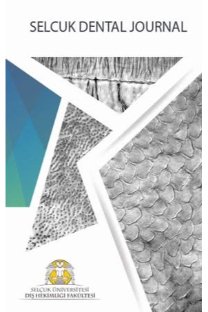Self-adeziv rezin simanın tek başına ya da selfetch adeziv sistemle birlikte kullanımının push-out bağlanma dayanımına etkisi
Effect of single use or combine use with self-etch adhesive system of self-adhesive rezin cement on push-out bond strength
___
- 1. Goracci C, Ferrari M. Current perspectives on post systems: a literature review. Aust Dent J. 2011; 56 Suppl 1: 77-83.
- 2. Chuang SF, Yaman P, Herrero A, et al. Influence of post material and length on endodontically treated incisors: an in vitro and finite element study. J Prosthet Dent. 2010; 104: 379-88.
- 3. Chieruzzi M, Pagano S, Pennacchi M, et al. Compressive and flexural behaviour of fibre reinforced endodontic posts. J Dent. 2012; 40: 968-78.
- 4. Kedici SP, Aksut AA, Kilicarslan MA, et al. Corrosion behaviour of dental metals and alloys in different media. J Oral Rehabil. 1998; 25: 800-8.
- 5. Baba NZ, Golden G, Goodacre CJ. Nonmetallic prefabricated dowels: a review of compositions, properties, laboratory, and clinical test results. J Prosthodont. 2009; 18: 527-36.
- 6. Bonfante EA, Pegoraro LF, de Goes MF, Carvalho RM. SEM observation of the bond integrity of fiber-reinforced composite posts cemented into root canals. Dent Mater. 2008; 24: 483-91.
- 7. Boschian Pest L, Cavalli G, Bertani P, Gagliani M. Adhesive post-endodontic restorations with fiber posts: pushout tests and SEM observations. Dent Mater. 2002; 18: 596-602.
- 8. Butz F, Lennon AM, Heydecke G, Strub JR. Survival rate and fracture strength of endodontically treated maxillary incisors with moderate defects restored with different post-and-core systems: an in vitro study. Int J Prosthodont. 2001; 14: 58-64.
- 9. Cecchin D, de Almeida JF, Gomes BP, et al. Influence of chlorhexidine and ethanol on the bond strength and durability of the adhesion of the fiber posts to root dentin using a total etching adhesive system. J Endod. 2011; 37: 1310-5.
- 10. Tay FR, Pashley DH. Monoblocks in root canals: a hypothetical or a tangible goal. J Endod. 2007; 33: 391-8.
- 11. Radovic I, Monticelli F, Goracci C, et al. Self-adhesive resin cements: a literature review. J Adhes Dent. 2008; 10: 251-8.
- 12. Macedo VC, Faria e Silva AL, Martins LR. Effect of cement type, relining procedure, and length of cementation on pull-out bond strength of fiber posts. J Endod. 2010; 36: 1543-6.
- 13. Ebert J, Leyer A, Gunther O, et al. Bond strength of adhesive cements to root canal dentin tested with a novel pull-out approach. J Endod. 2011; 37: 1558-61.
- 14. DArcangelo C, Cinelli M, De Angelis F, DAmario M. The effect of resin cement film thickness on the pullout strength of a fiber-reinforced post system. J Prosthet Dent. 2007; 98: 193-8.
- 15. Kremeier K, Fasen L, Klaiber B, Hofmann N. Influence of endodontic post type (glass fiber, quartz fiber or gold) and luting material on push-out bond strength to dentin in vitro. Dent Mater. 2008; 24: 660-6.
- 16. Ari H, Yasar E, Belli S. Effects of NaOCl on bond strengths of resin cements to root canal dentin. J Endod. 2003; 29: 248-51.
- 17. Goracci C, Tavares AU, Fabianelli A, et al. The adhesion between fiber posts and root canal walls: comparison between microtensile and push-out bond strength measurements. Eur J Oral Sci. 2004; 112: 353-61.
- 18. Cekic-Nagas I, Ergun G, Nagas E, et al. Comparison between regional micropush-out and microtensile bond strength of resin composite to dentin. Acta Odontol Scand. 2008; 66: 73-81.
- 19. Soares CJ, Santana FR, Castro CG, et al. Finite element analysis and bond strength of a glass post to intraradicular dentin: comparison between microtensile and pushout tests. Dent Mater. 2008; 24: 1405-11.
- 20. Schwartz RS, Robbins JW. Post placement and restoration of endodontically treated teeth: a literature review. Journal of endodontics. 2004; 30: 289-301.
- 21. Glazer B. Restoration of endodontically treated teeth with carbon fibre posts--a prospective study. 2000; 66: 613-8.
- 22. Ferrari M, Vichi A, Garcia-Godoy F. Clinical evaluation of fiber-reinforced epoxy resin posts and cast post and cores. American journal of dentistry. 2000; 13: 15B-8B.
- 23. Cecchin D, de Almeida JF, Gomes BP, et al. Effect of chlorhexidine and ethanol on the durability of the adhesion of the fiber post relined with resin composite to the root canal. J Endod. 2011; 37: 678-83.
- 24. Erdemir U, Sar-Sancakli H, Yildiz E, et al. An in vitro comparison of different adhesive strategies on the micro push-out bond strength of a glass fiber post. Med Oral Patol Oral Cir Bucal. 2011; 16: e626-34.
- 25. Juloski J, Fadda GM, Radovic I, et al. Push-out bond strength of an experimental self-adhesive resin cement. Eur J Oral Sci. 2013; 121: 50-6.
- 26. Gerth HU, Dammaschke T, Zuchner H, Schafer E. Chemical analysis and bonding reaction of RelyX Unicem and Bifix composites--a comparative study. Dent Mater. 2006; 22: 934-41.
- 27. Kitzmuller K, Graf A, Watts D, Schedle A. Setting kinetics and shrinkage of self-adhesive resin cements depend on cure-mode and temperature. Dent Mater. 2011; 27: 544- 51.
- ISSN: 1300-5170
- Yayın Aralığı: Yılda 3 Sayı
- Başlangıç: 1991
- Yayıncı: İsmail Marakoğlu
Leyla B. AYRANCI, Hakan ARSLAN, H. Sinan TOPÇUOĞLU
Betül GÜNEŞ, Hale AYDINBELGE ARI
Tooth shade assessment after lingual retainer application: A prospective clinical trial
Hasan Önder GÜMÜŞ, Faruk İzzet UÇAR, Hayriye ŞENTÜRK, Tancan UYSAL
Zirkonya: Yapısı ve altyapı üretim tekniği
Toplumumuzda diş ipi kullanma alışkanlığı
İki farklı porselen laminate veneer restorasyonun kenar uyumunun in-vitro olarak değerlendirilmesi+
MERAL ARSLAN MALKOÇ, Atiye Nilgün ÖZTÜRK, Şerife Tuba BÜYÜKÖZER, Bora ÖZTÜRK
Hakan ARSLAN, Çağatay BARUTCİGİL, Duygu KÜRKLÜ, Hüseyin ERTAŞ
Obezitenin tükürük PH'sı, tamponlama kapasitesi ve diş çürüğü insidansı'na etkisi+
Abdulkadir ŞENGÜN, NAZMİYE DÖNMEZ, İsmet DURAN, H.Esra ÜLKER
In vitro evaluation of marginal leakage using various temporary filling materials
Ayçe ELDENİZ ÜNVERDİ, MAKBULE BİLGE AKBULUT, MEHMET BURAK GÜNEŞER
